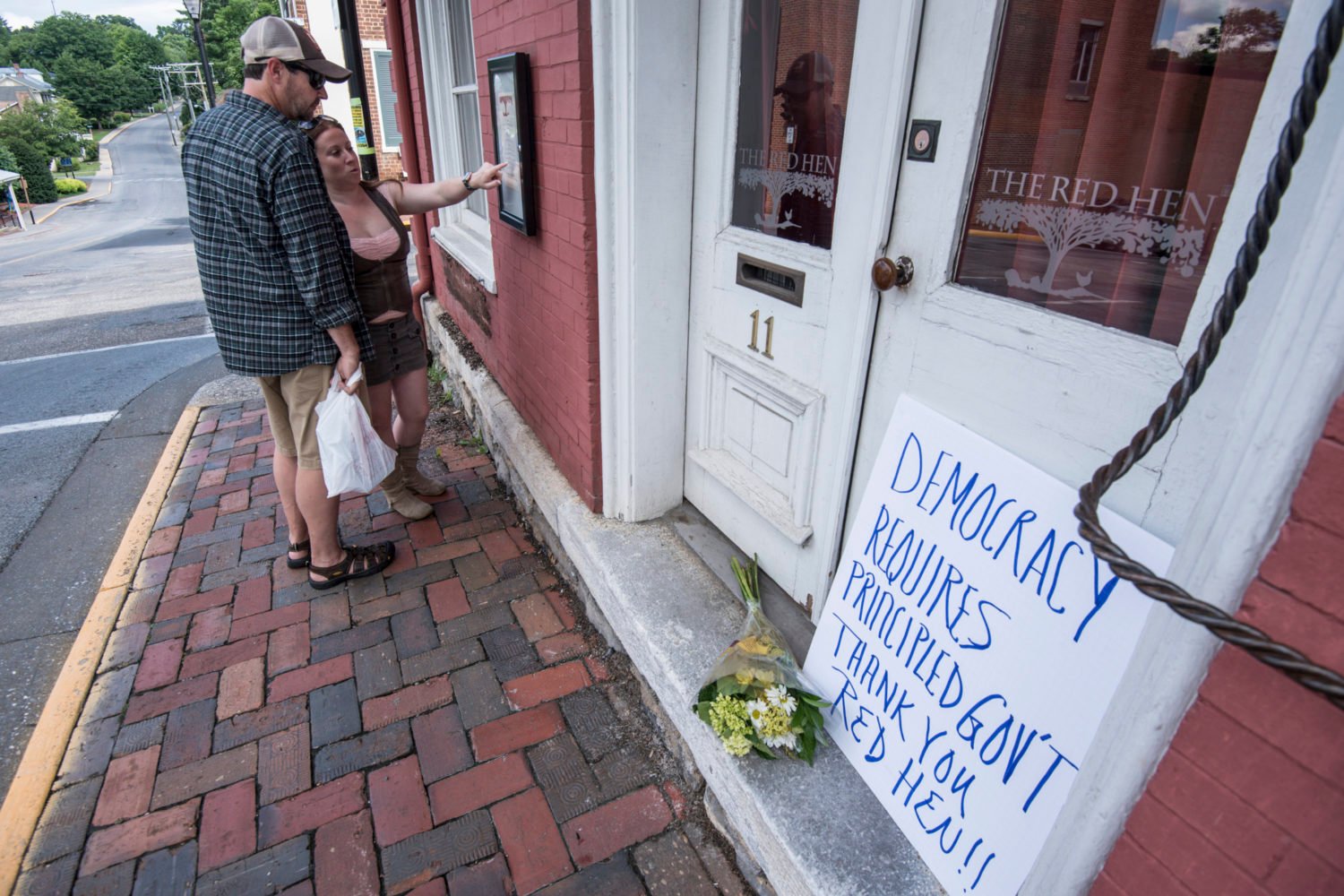Amanda Werner‘s friend was dining at MXDC when he recognized none other than Kirstjen Nielsen at the sleek downtown Mexican restaurant—just a day after the Department of Homeland Security Secretary defended the separation of children from their parents at the border.
He immediately texted Werner: “DHS Secretary Nielsen is having dinner at MXDC. Can you tweet on your account? Get activists here.” He sent a snapshot of the Trump Cabinet member in a black suit checking her phone at a nearby table.
Werner, who identifies as transmasculine and uses they/them pronouns, is a campaign strategist for legal advocacy group Public Justice. But in the past year, Werner has also made a hobby out of confronting the rich and powerful. Last October, they went viral after dressing up as the Monopoly Man and photo-bombing the CEO of Equifax during a Senate hearing about the company’s data breach. More recently, they showed up as a Russian troll at the congressional hearing for Mark Zuckerberg.
Werner’s protests are mostly solo, but in this case, they texted at least 20 friends, messaged another 15 or so on Facebook, reached out to a couple organizing groups, and blasted the Nielsen sighting out on Twitter. Members of Metro DC Democratic Socialists of America seized on the call to action and rallied its members and followers to meet at the restaurant and confront Nielsen.
Encountering powerful and controversial people shopping for groceries, dining at restaurants, or hitting up SoulCycle has always been a normal facet of DC life. And for the most part, there’s an unspoken code that we allow them to go about their daily lives uninterrupted. At most, maybe someone snaps a photo and sends it to Politico Playbook. But with Nielsen, at this moment of widespread outrage and exasperation, something was different.
“This administration just rises to a whole new level where we need to break the rules of etiquette,” Werner says. “People are more willing to reconsider our old social constructs of respect and politeness and realizing there are more important things that are at stake.”
Werner was about to get on the Metro at Dupont Circle to head to a book club meeting but instead rerouted to MXDC. They were the first person to arrive at the restaurant. “We didn’t know how long [Nielsen] had been there, how much longer she was going to stay there, so I was fully prepared to just confront her myself,” Werner says.
Within about ten minutes, others started to show up. In total, the protest included about a dozen people, Werner says. Among them was Margaret McLaughlin, a member of MDCDSA’s steering committee.
“I was feeling pretty dejected and hopeless by the news of the past couple days, hearing the audio of the kids in detention,” McLaughlin says. She was all set to put on her pajamas and binge-watch some Netflix, but a text about Nielsen changed her plans. “I think a lot of people wanted to scream at Kirstjen Nielsen as a result of this policy,” she says.
As a member of MDCDSA, McLaughlin had been involved in protests before. This spring, the group organized outside the homes of “deportation profiteers,” including a former ICE attorney and a lobbyist for detention center operator CoreCivic. “They live in neighborhoods like Capitol Hill and Dupont, which have a surrounding community which is fairly progressive, and we want to expose these people to their neighbors,” a spokesperson for MDCDSA explains.
Normally, the group takes four to six weeks to plan and research an “action.” This was its first spur-of-the-moment protest.
Gathered outside the restaurant, the group decided it would be best to confront Nielsen inside the dining room. They wanted to force her to listen to them longer. They quickly worked out a few chants but decided their primary chant would be “Shame! Shame! Shame!”
As they initially confronted Nielsen, Werner says a manager asked them to leave. They walked past him. MXDC owner Aziz Safi had already left for the day, but a manager called him, and he stayed on the line getting updates.
“Secretary Nielsen, how dare you spend your evening here eating dinner as you’re complicit in the separation and deportation of over 10,000 children,” one of the protestors shouts at the start.
McLaughlin filmed the encounter and streamed it live on Facebook. She’s the one who yells out, “Homeland Security Secretary Kirstjen Nielsen is in a Mexican restaurant of all places! The fucking gall!”
https://www.facebook.com/MetroDCDSA/videos/803604196505574/
The protesters continued their chants: “Abolish ICE! Abolish ICE!.,” “If kids don’t eat in peace, you don’t eat in peace!,” and “Kirstjen Nielsen, you’re a villain, locking up immigrant children.”
Someone happened to have a Bluetooth speaker, so they played the audio clip of children crying in border detention centers.
Brent Epperson, a post-doctoral researcher visiting DC from Alberta, Canada, was having some drinks with colleagues at MXDC at the time. “More than half the restaurant, once they realized who it was and what they were protesting, started clapping for the protesters,” Epperson says. “I clapped along. At such an unusual time in this country’s political history, I think there’s a democratic duty to speak up and show disapproval for what’s happening.”
But Werner noticed that a bunch of other diners looked annoyed at the disruption. “I turned to the diners and just said, ‘If you ever wondered how you were going to act in a major historical moment, you’re doing it right now.'”
Nielsen, who was having dinner with another person, looked down at her half-eaten salad and her phone rather than acknowledge the protestors. Two Secret Service agents created a barrier in front of her.
The entire protest lasted 15 to 20 minutes. About halfway through, the protestors started speculating that the police might show up. They quickly debated whether they should disperse or stay and potentially get arrested. “Everybody there uniformly decided we would stay to be arrested, because we all just thought it was important enough that we would do as much as we possibly could,” Werner says.
But after a while, the police still hadn’t arrived.
“We ran out of chants, so we eventually were like, well, I think we’ve made our point, they’re not going to come, I guess we should leave at some point,” Werner says.
As the protesters exited, people cheered and clapped, McLaughlin says. A few gave them high-fives or came outside to thank them. Werner says even the restaurant staff, most of whom are Hispanic, seemed into it: “I did see a lot of the waiters and busboys were kind of smiling at us and seemed to be enjoying the fact that we were calling this woman out.”
Nielsen left shortly after, beelining into a black SUV.
Werner says when they were about half a block a way from the restaurant, the Secret Service detained some of the protesters on the sidewalk. Werner alleges one of the officers violently yanked two of the protesters by their backpacks. Video footage shows what happened next: An officer tells them they’re being detained as they an investigate an assault. “You’re investigating an assault?” a protester of Latino descent asks. “Si,” responds the officer, in what the protesters interpreted was a sarcastic, condescending tone. The protesters demand to know what assault. “That’s what we’re trying to figure out,” the officer says.
After a few minutes, the protesters were allowed to leave.
https://www.facebook.com/MetroDCDSA/videos/803619266504067/
Secret Service responded with only this statement: “Secret Service personnel were involved in an incident this evening while executing our protective mission responsibilities at a restaurant in Washington, D.C. The incident involved a small group of people who entered a restaurant where a Secret Service protectee was dining. The group were not restaurant patrons and quickly dispersed. No arrests were made.”
Caught in the crossfire of the protest was the restaurant itself. Some in the social media mob called for a protest of the establishment for serving Nielsen in the first place. Others derided the management for allowing the protest to go on and bully guests.
For his part, Safi, the owner, has tried to remain diplomatic. He notes that the place has long hosted a lot of high-ranking government officials from both parties. “We respect their privacy. We accommodate them, and they like that. They feel like a normal customer,” he says. “We welcome everyone.”
Safi says his first concern was safety. There were some families, including kids in high chairs, in the dining room during the protest. At one point, someone did call the police, but he isn’t sure if it was his staff, Secret Service, or someone else. But he says it was quickly evident that the protest was peaceful.
“I’m glad when somebody wants to say something and protest, as long as it’s peaceful, it’s not harming anyone, we’re not against it,” Safi says. He adds that he was glad to see the next day that Trump signed an executive order to end the separation of parents and children at the border. Nielsen stood behind him as he did so. “That’s good news for us as a country,” Safi says. “I don’t know how much we had to do with it. There’s a lot of pushback.”
Werner, though, believes that, in whatever small way, their protest did matter.
“I do think that there’s a special power to confronting people face-to-face and really making them feel the heat,” Werner says. “Not many people want to be seen as villains in the world, so I think that definitely made some sort of difference.”

















